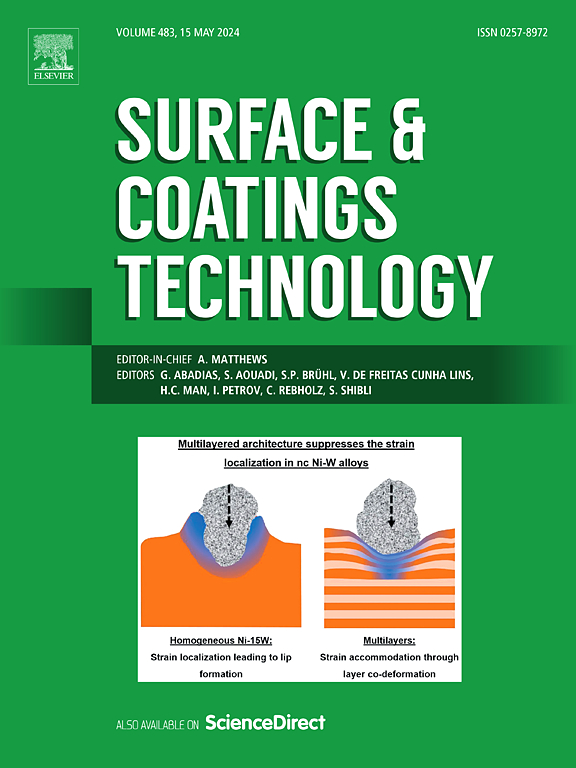Impurity sources and incorporation pathways during sputter deposition of Mg and Al thin films
IF 5.3
2区 材料科学
Q1 MATERIALS SCIENCE, COATINGS & FILMS
引用次数: 0
Abstract
Minimizing the impurity concentration in magnetron sputter deposited thin films is desired for the exploration of composition – structure – property relations. Thus, the integral impurity incorporation during growth into Mg and Al sputter deposited thin films is studied by systematic variations of the base pressure, the deposition rate, and the working gas purity. The deposition rate and the base pressure, which was measured before each deposition, were varied simultaneously, resulting in a variation of the impurity-to-metal flux ratios of factor > 40. During growth, Ar gas purities of 99.999 and 99.9999 % were employed. Surprisingly, these systematic growth condition variations did not significantly alter the impurity concentration incorporated into Mg and Al thin films. While the modified parameters clearly are relevant for impurity incorporation, there appears to be at least one additional mechanism affecting the impurity incorporation during thin film growth operational. Mass spectrometry data revealed that residual gases desorb from surfaces within the vacuum chamber as soon as they are heated. Based on the measured thin film composition data, it is inferred that the magnitude of thermally desorbed residual gas appears to affect the impurity concentration to a larger extent than the systematic deposition parameter variations studied here. Therefore, it is reasonable to assume that the here investigated impurity incorporation is governed by the incorporation of thermally desorbed residual gases during thin film growth. Future impurity incorporation studies should, in addition to the base pressure before deposition, also quantify the residual gas partial pressures present during deposition.
镁铝薄膜溅射沉积过程中的杂质来源及掺杂途径
将磁控溅射沉积薄膜中的杂质浓度降到最低,是探索组成-结构-性能关系的必要条件。因此,通过系统地改变基底压力、沉积速率和工作气体纯度,研究了生长过程中Mg和Al溅射沉积薄膜中整体杂质的掺入。每次沉积前测量的沉积速率和基压同时变化,导致因子>的杂质-金属通量比发生变化;40. 在生长过程中,氩气的纯度分别为99.999和99.9999%。令人惊讶的是,这些系统的生长条件变化并没有显著改变镁和铝薄膜中的杂质浓度。虽然修改后的参数显然与杂质掺入有关,但在薄膜生长操作过程中,似乎至少存在一种影响杂质掺入的附加机制。质谱分析数据显示,真空室的表面一旦被加热,残余气体就会被解吸。根据测量的薄膜成分数据,可以推断热解吸残余气体的大小似乎比本文研究的系统沉积参数变化对杂质浓度的影响更大。因此,可以合理地假设,本文研究的杂质掺入是由薄膜生长过程中热解吸残余气体的掺入所控制的。未来的杂质掺入研究,除了沉积前的基础压力外,还应量化沉积过程中存在的残余气体分压。
本文章由计算机程序翻译,如有差异,请以英文原文为准。
求助全文
约1分钟内获得全文
求助全文
来源期刊

Surface & Coatings Technology
工程技术-材料科学:膜
CiteScore
10.00
自引率
11.10%
发文量
921
审稿时长
19 days
期刊介绍:
Surface and Coatings Technology is an international archival journal publishing scientific papers on significant developments in surface and interface engineering to modify and improve the surface properties of materials for protection in demanding contact conditions or aggressive environments, or for enhanced functional performance. Contributions range from original scientific articles concerned with fundamental and applied aspects of research or direct applications of metallic, inorganic, organic and composite coatings, to invited reviews of current technology in specific areas. Papers submitted to this journal are expected to be in line with the following aspects in processes, and properties/performance:
A. Processes: Physical and chemical vapour deposition techniques, thermal and plasma spraying, surface modification by directed energy techniques such as ion, electron and laser beams, thermo-chemical treatment, wet chemical and electrochemical processes such as plating, sol-gel coating, anodization, plasma electrolytic oxidation, etc., but excluding painting.
B. Properties/performance: friction performance, wear resistance (e.g., abrasion, erosion, fretting, etc), corrosion and oxidation resistance, thermal protection, diffusion resistance, hydrophilicity/hydrophobicity, and properties relevant to smart materials behaviour and enhanced multifunctional performance for environmental, energy and medical applications, but excluding device aspects.
 求助内容:
求助内容: 应助结果提醒方式:
应助结果提醒方式:


